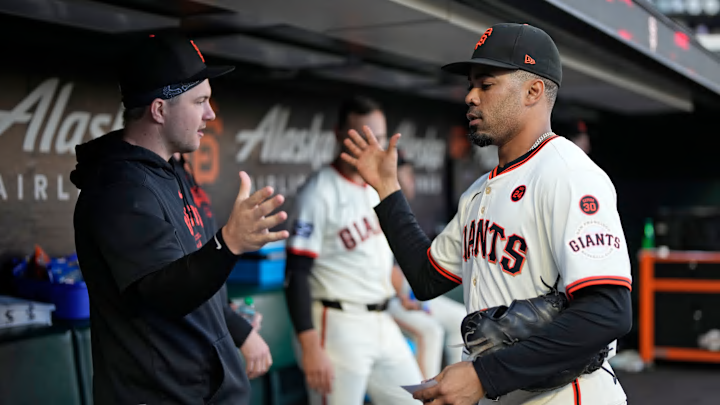A pair of SF Giants hitters in LaMonte Wade Jr. and Patrick Bailey are off to brutal starts to the 2025 season. The cause might be related to an unusually high spike in launch angle.
2 slumping SF Giants hitters share 1 2025 adjustment in common
The topline numbers are pretty tough to look at, as Bailey has struggled to a .477 OPS while Wade Jr. has posted a .491 OPS this season. Bailey continues to provide elite defense behind the plate and catcher is a tough position to replace in the middle of the season, so the Giants might have no other option but to ride this out.
On the other hand, first base is a bat-first position. Wade Jr. may only continue to see everyday at-bats for another couple of weeks until Jerar Encarnación returns from a rehab assignment. At that point, Encarnación could pretty quickly supplant Wade Jr. at first base.
With Bailey and Wade Jr., launch angle seems to be part of the reason for their slumps. Among Giants hitters, both have seen the largest year-over-year increase in launch angle on the team. For Wade Jr., his average launch angle is 26.6 degrees, up from 12.9 degrees in 2024. For Bailey, his average launch angle is 20.8 degrees, up from 12.1 degrees last season.
Wade Jr. has the highest launch angle among all qualified hitters this season. The reason behind the change is likely due to trying to generate more power by getting the ball in the air more frequently. Both Wade Jr. and Bailey had line-drive swings last season, but they have swings designed more for fly-ball contact in 2025.
That has had some major side effects. For Bailey, he has seen a massive spike in his strikeout rate to 33.9 percent. That rate is way too high for any hitter, especially for one who does not hit for much power in the first place. The cause of the high strikeout rate is due in large part to a decline in contact rate on pitches in the zone. His swing has too much lift, leaving him vulnerable to pitches he has generally made contact with in the past.
There has also been a shift in his batted-ball data, as his fly-ball rate has nearly doubled to 47.2 percent. The tradeoff here is a huge decline in his line-drive rate. Line drives tend to result in hits at a high rate, so the switch-hitter is making that tradeoff without a corresponding increase in power.
On the other hand, Wade Jr.'s strikeout rate is not too far from his career norm. There is not necessarily a concern here as is the case with Bailey.
What has changed is what happens when Wade Jr. makes contact. Similar to Bailey, his fly-ball rate is up to 38.6 percent this season. There has not been as sharp of a tradeoff between fly balls and line drives, as his line-drive rate remains healthy at 25.3 percent.
The left-handed bat has seen his pop-up rate balloon to 10.8 percent this year, up from 3.3 percent last season. In terms of getting the ball in the air, pop ups are the worst outcome because the expected batting average is so low. Front offices tend to view pop ups as strikeouts.
In both cases, Bailey and Wade Jr.'s topline numbers are consistent with their expected numbers. That latter detail is due to how they are hitting the ball, which is not very well at the moment. The Giants will be patient with Bailey to work out of his struggles, as they do not have any other alternatives. On the other hand, Wade Jr. might need to turn it around quickly. Either way, both hitters need to get back to a point where they are hitting more line drives again.
